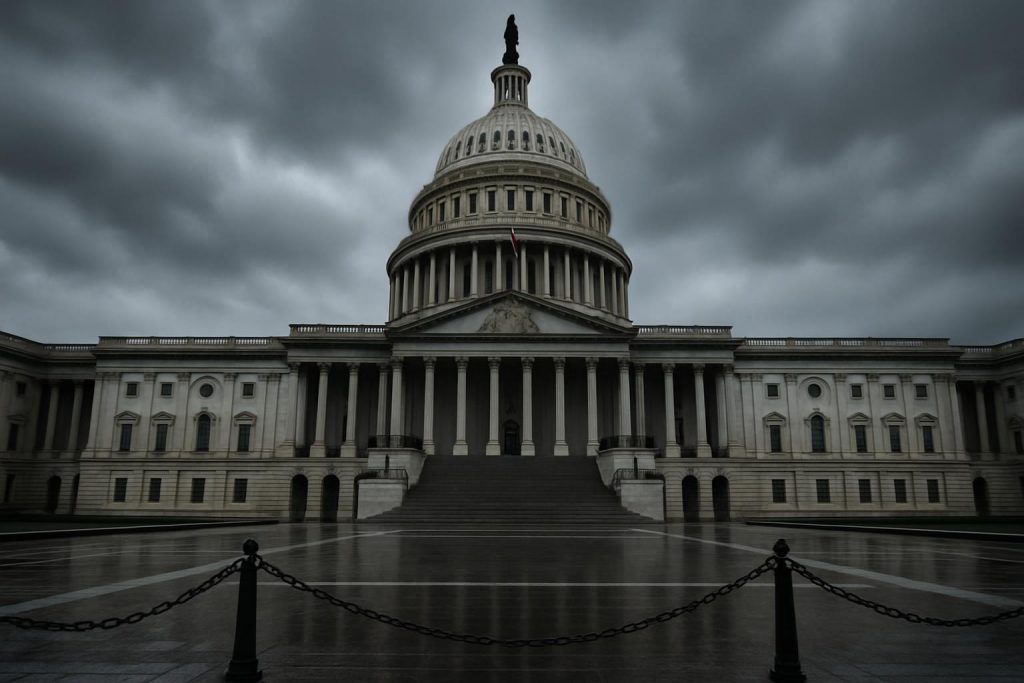Bitcoin Soars to $125K During US Government Shutdown Crisis

Introduction: A Tale of Two Capitals
On October 1, 2025, an eerie quiet fell over Washington D.C. as the U.S. federal government officially shut down, shuttering national parks, furloughing hundreds of thousands of workers, and grinding the machinery of state to a halt, as detailed in official government shutdown FAQs. The nation’s political capital was a portrait of paralysis, caught in a bitter legislative stalemate. Yet, thousands of miles away in the decentralized, 24/7 digital capital of the cryptocurrency markets, the silence was replaced by a deafening roar. As one system seized, another accelerated into a historic, record-shattering rally.
The October 2025 government shutdown was more than a political spectacle; it was a real-time stress test that catalyzed a fundamental re-evaluation of cryptocurrency’s role in a global portfolio. The unique nature of this crisis—marked by unprecedented economic threats and a crippling “data blackout”—provided the ultimate validation for the “debasement trade,” a strategy of moving capital away from assets vulnerable to government mismanagement. This report will demonstrate that the shutdown served as a pivotal moment, cementing Bitcoin’s status not merely as a speculative instrument, but as a credible non-sovereign store of value and a legitimate hedge against systemic political and economic dysfunction.
Section 1: Anatomy of a Shutdown: Data Blackouts and Economic Disarray
The market’s dramatic reaction was not born in a vacuum; it was a direct response to the specific and severe nature of the macroeconomic disruption emanating from Washington. The catalysts for the crypto surge were rooted in a political impasse that bred deep economic uncertainty and, critically, informational blindness.
The Political Impasse
The shutdown commenced after Congress failed to pass the necessary appropriations bills to fund federal agencies into the new fiscal year. The deadlock stemmed from a deep ideological chasm between Senate Democrats and the Republican majority under President Donald Trump, a dispute costing the economy millions daily. At the heart of the dispute were Democratic demands to extend expiring healthcare subsidies under the Affordable Care Act (ACA) and to reverse Medicaid cuts that were part of the administration’s sweeping “One Big Beautiful Bill Act” spending and tax cut package, a key reason why this shutdown was different. Republicans, in turn, refused to fund what they characterized as an unacceptable expansion of “Obamacare,” while President Trump insisted he would not be “held hostage” by these demands. With neither side willing to yield, the government’s funding lapsed, triggering the shutdown.
An Unprecedented Economic Threat: From Furlough to Permanent Layoffs
The immediate economic consequences were stark. Approximately 750,000 federal employees were either furloughed or forced to work without pay, draining an estimated $400 million from the economy each day. Non-essential government services ceased across the board, creating a ripple effect of disruption that impacted everything from national parks to federal contracts.
However, this shutdown carried a threat that distinguished it from the 21 previous instances. The Trump administration signaled its intent to use the funding lapse not just for temporary furloughs, but as a pretext for permanent layoffs through Reduction in Force (RIF) notices, a development covered by the Associated Press. This transformed the crisis from a temporary political squabble into a potential permanent shock to the U.S. labor market, an implication analyzed by The Conference Board. The risk calculus for investors shifted dramatically. The shutdown was no longer just a temporary drag on GDP; it was perceived as a moment where the executive branch might leverage a funding dispute to permanently alter the federal economic apparatus, amplifying the “debasement” narrative and making non-sovereign assets appear far more rational.
The Data Blackout: Flying Blind in a Volatile Economy
Perhaps the most destabilizing consequence of the shutdown was the creation of an information vacuum. Key data-gathering agencies, most notably the Bureau of Labor Statistics (BLS), suspended all operations. This immediately delayed the release of the highly anticipated September jobs report, weekly unemployment claims, and forthcoming inflation and retail sales reports, effectively cutting off vital economic data.
The timing of this “data blackout” could not have been worse. The U.S. economy appeared to be at a critical inflection point, with private payroll data suggesting a cooling job market while other indicators pointed to persistent inflation, a situation exacerbated by the delayed jobs report. Without official government statistics, investors, policymakers, and especially the Federal Reserve were left “flying blind,” as The Washington Post noted. The Fed faced its upcoming October 28-29 meeting with a compromised ability to make informed decisions on interest rates.
This paralysis of the traditional financial system’s information pipeline created a stark contrast with the world of digital assets. While official economic reporting ceased, the transparent, immutable, and continuously updated public ledgers of blockchains like Bitcoin and Ethereum remained perfectly intact and accessible 24/7, a reality that spurred a spike in crypto demand. The resulting market rally was therefore not just a flight from the U.S. dollar, but a flight from informational uncertainty to informational integrity. Capital flowed to the only major market where the data was still reliable and the rules of the system remained clear and unaltered.
Section 2: The ‘Debasement Trade’ Ignites: Crypto’s Flight to Safety
As Washington descended into chaos, capital markets responded with a decisive rotation into assets perceived as immune to political dysfunction. The “debasement trade” ignited, fueling a historic, broad-based rally across the digital asset ecosystem.
Bitcoin Leads the Charge
Bitcoin, the market’s bellwether, experienced a parabolic surge. After starting the month below $115,000, its price rocketed upward, smashing its previous record to set a new all-time high of $125,689, a move driven by the ‘debasement trade’ narrative. This explosive move pushed Bitcoin’s market capitalization past $2.4 trillion, a milestone that saw it overtake the valuation of corporate giant Amazon to become the world’s seventh most valuable asset.
A Broad-Based Rally
This was not a speculative frenzy isolated to a single asset. The rally lifted the entire digital asset space, with the total cryptocurrency market capitalization swelling to over $4.2 trillion, as detailed in daily market performance reports. Major alternative cryptocurrencies, or “altcoins,” posted impressive gains, signaling a sophisticated allocation of capital across the ecosystem. Ethereum (ETH) reclaimed the critical $4,700 level, while Binance Coin (BNB) surged past $1,200 to a new all-time high of its own. Other established projects like Solana (SOL) and XRP also saw significant price increases, demonstrating that investors were diversifying into the broader decentralized economy thesis, a trend noted by analysts at MarketPulse.
The Institutional Stampede: ETF Inflows as Rocket Fuel
The primary mechanism for this capital flight was the suite of U.S.-based spot Bitcoin exchange-traded funds (ETFs). These regulated financial products, offered by mainstream giants like BlackRock and Fidelity, served as the critical on-ramp for institutional and retail investors seeking shelter from the uncertainty plaguing the traditional system. The data reveals a veritable stampede: in the week ending October 3, these ETFs recorded a massive $3.24 billion in net inflows, bringing their cumulative total since launch to over $59 billion and defying the U.S. shutdown fears. This flood of capital was the rocket fuel for the rally, providing the demand shock that propelled prices to new highs.
Corroborating Evidence: The Multi-Asset Rotation
The surge in crypto did not happen in isolation; it was part of a coordinated flight from sovereign assets. Gold, the traditional safe-haven asset, rallied in near-perfect unison with Bitcoin, smashing its own records to briefly breach $3,900 and even $4,000 per ounce, a parallel move highlighting safe-haven demand. Concurrently, traditional risk indicators reflected the growing anxiety. U.S. Treasury yields fell as the market priced in a higher probability of Fed rate cuts to counteract the shutdown’s economic damage, even as Wall Street set new records. The U.S. Dollar Index (DXY) weakened, with some analysts describing it as merely the “lesser evil” compared to political turmoil in Europe and Japan. This multi-asset rotation confirms that the crypto rally was a key component of a broader, rational response to perceived sovereign risk. The shutdown provided the first large-scale, real-world evidence in a developed market crisis that institutional capital views Bitcoin and gold as complementary safe-haven assets, moving the “digital gold” narrative from a theoretical talking point to a demonstrated market reality.

Section 3: Not Your Father’s Shutdown: A Historical Analysis of Market Maturity
To fully appreciate the significance of the October 2025 rally, it is essential to place it in historical context. The crypto market’s behavior during this shutdown stands in stark contrast to its performance during the longest-ever shutdown in 2018-2019, revealing a fundamental maturation of the asset class and its underlying infrastructure.
The following table provides a direct comparison of market performance during the two periods:
| Metric | 2018-2019 Shutdown (35 days) | October 2025 Shutdown (Ongoing) |
|---|---|---|
| Bitcoin Performance | −10.32% | +30% (approx.) to new ATH |
| Ethereum Performance | −0.32% | Significant gains, reclaiming >$4,700 |
| S&P 500 Performance | Initial decline, then positive return | Resilient, new highs |
| Gold Performance | Moderate gains | Surge to new ATH |
| U.S. Dollar Index (DXY) | Drifted lower | Weakness/Stagnation |
| Key Market Infrastructure | Primarily retail exchanges | Spot ETFs, corporate treasuries, robust derivatives markets |
Analysis of the Divergence
The data reveals a dramatic reversal of roles. During the 2018-2019 shutdown, Bitcoin behaved like a speculative risk asset, selling off alongside initial equity weakness—a historical trend for crypto during shutdowns. In 2025, it acted as a premier safe-haven asset, rallying alongside gold. As Geoff Kendrick, global head of digital assets research at Standard Chartered, noted, the cryptocurrency was “in a different place” during the previous shutdown and did not move in line with traditional risk assets.
This evolution can be attributed almost entirely to the development of a robust, institutional-grade market structure. In 2019, the primary on-ramps to crypto were largely unregulated offshore exchanges, making it difficult for institutional asset managers to allocate significant capital. The market was siloed and lacked the “financial plumbing” to absorb a flight to safety from the traditional world.
By 2025, this landscape had been transformed. The launch and success of spot Bitcoin ETFs provided a regulated, accessible, and highly liquid bridge for capital, fueling what some called an ‘Uptober’ rally. An institutional portfolio manager could now gain exposure to Bitcoin as easily as buying a share of any other stock. Furthermore, the pioneering efforts of corporations like MicroStrategy to adopt Bitcoin as a treasury reserve asset had normalized its role in a corporate balance sheet, a concept that was still nascent in 2019. The story of the 2025 rally is not just that investors wanted to buy Bitcoin as a hedge, but that for the first time, they could do so at scale. The shutdown didn’t just test the Bitcoin thesis; it stress-tested and validated the entire institutional-grade market structure built around it over the preceding years.
Section 4: The Unseen Costs: Regulatory and Legislative Limbo
While the shutdown acted as a powerful short-term catalyst for the crypto market, its second-order effects created significant long-term headwinds. The very paralysis in Washington that fueled the rally simultaneously froze the regulatory and legislative processes essential for the industry’s sustainable growth, creating a dangerous paradox.
The SEC Grinds to a Halt
With over 90% of its staff furloughed, the Securities and Exchange Commission (SEC) was reduced to a skeleton crew capable of handling only critical enforcement actions, according to guidance for public companies. All other functions ceased. The agency announced it would not review or comment on filings, would not issue interpretive advice, and, most importantly, would not be able to declare new registration statements effective.
A Logjam in Capital Markets
This operational halt brought the booming 2025 market for initial public offerings (IPOs) to a standstill, threatening to stall its recovery. Several crypto-related technology companies had successfully gone public earlier in the year, and the shutdown threatened to stall this momentum, chilling capital formation for the entire sector. The freeze also directly impacted the evolution of crypto-based financial products. The review processes for potential new spot ETFs for assets like Solana and Litecoin were effectively paused, delaying innovation and preventing the expansion of regulated on-ramps for investors, a topic discussed in market analysis videos.
Legislative Momentum Stalls
Prior to the shutdown, significant progress was being made on comprehensive cryptocurrency legislation. Lawmakers in the Senate Banking Committee were deep in the process of drafting a landmark market structure bill to provide clear jurisdictional lines between the SEC and the Commodity Futures Trading Commission (CFTC). With the expert agency staff needed for technical feedback furloughed, the legislative momentum stalled. According to reporting from The Block, policy experts warned that a prolonged impasse would significantly jeopardize the bill’s chances of passing before the 2026 midterm elections dominate the political calendar.
This situation created a “regulatory deficit.” The longer the shutdown-fueled rally continued, the wider the gap grew between the market’s soaring valuation and the regulatory clarity needed to support it. The market was rallying on a narrative of being a superior, independent system, while its real-world integration into the existing financial system—via new products and clear laws—was being actively prevented by the same catalyst. This set the stage for a potential “re-opening shock,” where the resolution of the shutdown could remove the bullish macro driver while re-introducing a complex and uncertain regulatory reality.
Section 5: Expert Perspective: Navigating the Post-Shutdown Landscape
The shutdown has irrevocably altered the narrative surrounding digital assets, but as the initial euphoria gives way to consolidation, investors must navigate a complex landscape of bullish long-term fundamentals and significant short-term risks.
Analyst Projections and Technical Levels
The market’s powerful breakout has led to bullish short-to-medium-term projections. Several analysts are now targeting a move toward the $130,000-$135,000 range, with some technical models projecting a potential rally to $160,000 over the coming months, as part of the ongoing ‘Uptober’ rally.
From a technical perspective, key levels are now in focus. The new all-time high around $125,000-$127,000 serves as the immediate resistance zone. On the downside, the prior resistance level around $120,000 is the first critical area of support that bulls must defend to maintain momentum, a level watched closely as prices surged. Below that, more significant support clusters are found near $115,000 and, more critically, at $107,000, which corresponds to previous highs and key moving averages, according to MarketPulse analysis.
Risks to the Rally: A Necessary Dose of Caution
Despite the bullish sentiment, significant risks remain. Market indicators show sentiment is firmly in “greed” territory, and some metrics suggest the market is overbought, making it vulnerable to a wave of profit-taking and leading to a minor pullback. The approaching one-week mark of the shutdown was cited as one reason for a minor pullback, as investors were reminded of the vulnerability of risk assets during prolonged political instability, contributing to a slide in Bitcoin’s price. The most apparent risk is a “sell the news” event: once the shutdown ends, the primary catalyst for the flight to safety will be removed, which could trigger a sharp correction.
Furthermore, it is crucial to acknowledge the persistent counter-arguments to the “safe haven” narrative. Critics correctly point out that Bitcoin’s inherent price volatility remains a significant hurdle to its classification as a stable store of value, a key risk outlined by Fidelity. In some market regimes, it has shown a positive correlation to equities, limiting its effectiveness as a hedge in certain market conditions. These are valid concerns that temper the unbridled optimism and highlight the asset’s unique risk profile compared to traditional havens like gold.
The Long-Term Implications: Has the Game Changed Permanently?
The October 2025 government shutdown will be remembered as a watershed moment for cryptocurrency. It provided a live-fire stress test of the market’s infrastructure and its core macro-narrative under severe, real-world conditions. The lockstep rally with gold, fueled by unprecedented institutional inflows via ETFs, offers compelling evidence that the perception of Bitcoin among global asset allocators has fundamentally changed since 2019.
The immediate aftermath of the shutdown will be defined by a tug-of-war between two powerful, opposing forces. On one hand, the end of the crisis will remove the powerful “flight to safety” tailwind, potentially triggering a correction. On the other hand, a functioning government will unfreeze the SEC and Congress, possibly re-introducing a positive regulatory tailwind through new product approvals and legislative progress. The market’s ability to hold its gains after the chaos subsides will be the next great test. While a short-term correction is certainly possible, the shutdown appears to have permanently upgraded crypto’s role in the global financial system. It didn’t just fuel a rally; it forged a new macro asset.

